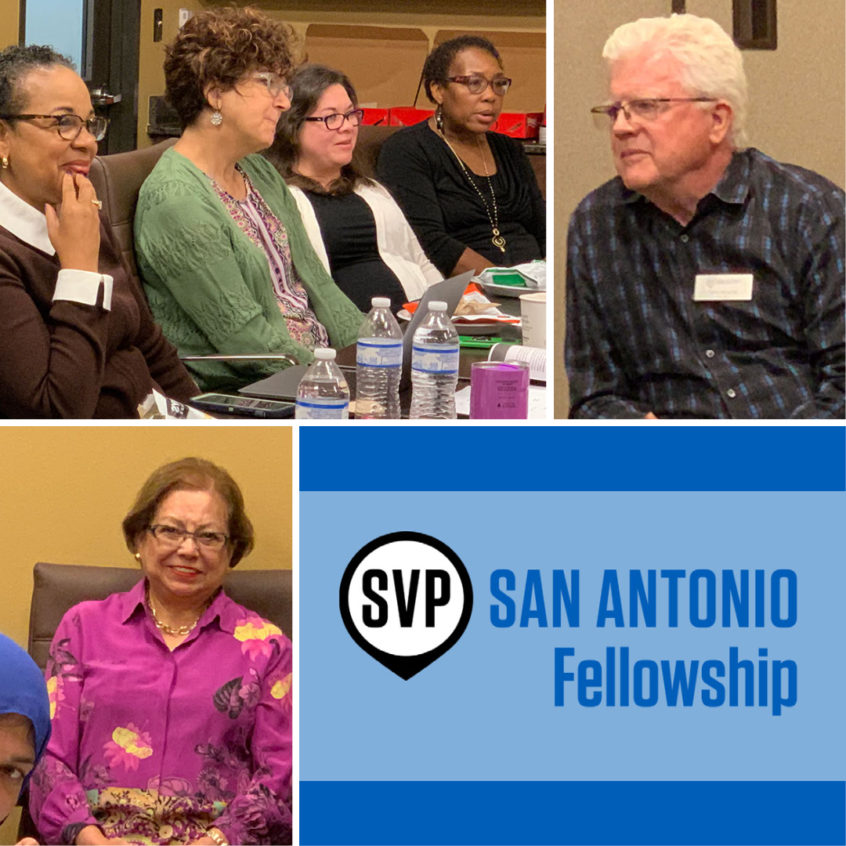The 2021 SVPSA Fellowship class met for its second session on October 20 at the San Antonio Lighthouse for the Blind in the Eads building. The 17 nonprofit leaders in the program enjoyed another day of training and discussion focused this month on working well with their board and managing staff. The lunch program featured a Q&A with Hope Andrade and Kevin Moriarty, who shared anecdotes from their decades of experience with nonprofits and insight into effective management.
Hope Andrade celebrated the work the nonprofits in the community. She would know; her career exemplifies service to others as Co-Founder & Partner of GO RIO San Antonio River Cruises, former Texas Secretary of State, recent chair of VIA Metropolitan Transit, Texas Workforce Commissioner, Texas Department of Transportation Commissioner, chair of the San Antonio Chamber of Commerce and San Antonio Hispanic Chamber of Commerce, board member of the Alamo Trust and San Antonio Symphony, and the list goes on.
Kevin Moriarty also praised the leaders for the impact they have each day for so many in San Antonio. His experience also represents one of our city’s legendary servant leaders. Kevin served as President & CEO of Methodist Healthcare Ministries for more than 20 years before retiring in 2018. Under his leadership, the nonprofit co-owner of Methodist Healthcare dramatically expanded access to healthcare across the region, impacting hundreds of thousands of patients. He was a driving force behind development of the Texas Children’s Health Insurance Plan and the Texas Women’s Health Plan. From 1996 to 2018, Methodist Healthcare Ministries grew its nonprofit grant program to more than $25 million, helping thousands of families each year.
In a moderated discussion, Andrade and Moriarty shared their thoughts and answered questions on a variety of issues related to board management, answering questions like:
- How do you get the best from board members, remembering that they are volunteers?
- How do you address limited or no engagement from board members?
- How do you bring a board through the maturity cycle of an organization?
- How do you make champions of your trustees?
- How do you help a board embrace diversity, equity and inclusion principals and to embrace volunteers who come from outside the C-suite?
“Lead with trust, Moriarty said. “You have to trust that your board and staff have a well-meaning desire and are aligned with your values and purpose. Remember that you were hired because you are the subject matter expert. As that, you need to stand on who you are and what you know.”
On getting the best from your board, Andrade said, “Invest in the time you spend getting to know your board members from the beginning. If you do that and they feel like you care and that you appreciate them and their expertise – and if you tell them what role and responsibility they will have – they will feel needed and appreciated. Help them understand how they are making a difference.”
About managing disengaged board members, Andrade’s advice was to focus on bringing on connected people.
“It’s best when the nominating committee brings in people they know, people they’ve shared their passion with and are now also inspired,” she said.
When it comes to maturing organizations, Moriarty believes in keeping things fresh and relevant to the current environment.
“It’s essential for the health of the organization that the documents and priorities cycle through groups of people,” he said. “Term limits are important. You need to look at the world you are currently serving and that is included in your strategic planning process. If you’re not doing strategic planning on a regular basis you will fail, you will not succeed.”
And the best way to make true champions of your board members? It’s about heart and understanding the bigger picture.
Moriarty said, “Elevate the conversation to what is wrong that needs to be changed from a policy perspective. Help them understand the issues you’re working on and why they matter. And if you can, look at the broader implications of what you are doing. Bring them a problem and a solution.”
“There is nothing like taking board members out of the board room to see what you are doing,” Andrade said. “Get out to see the impact. They’ve got to hear the success stories, not from you, but from the people you’re serving.”

